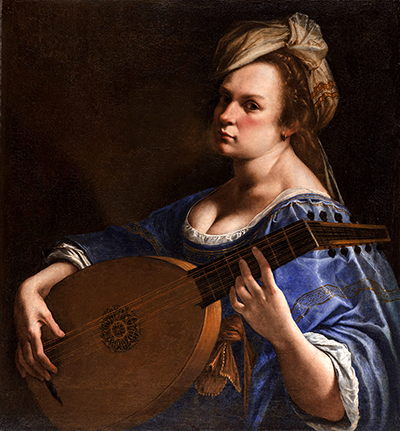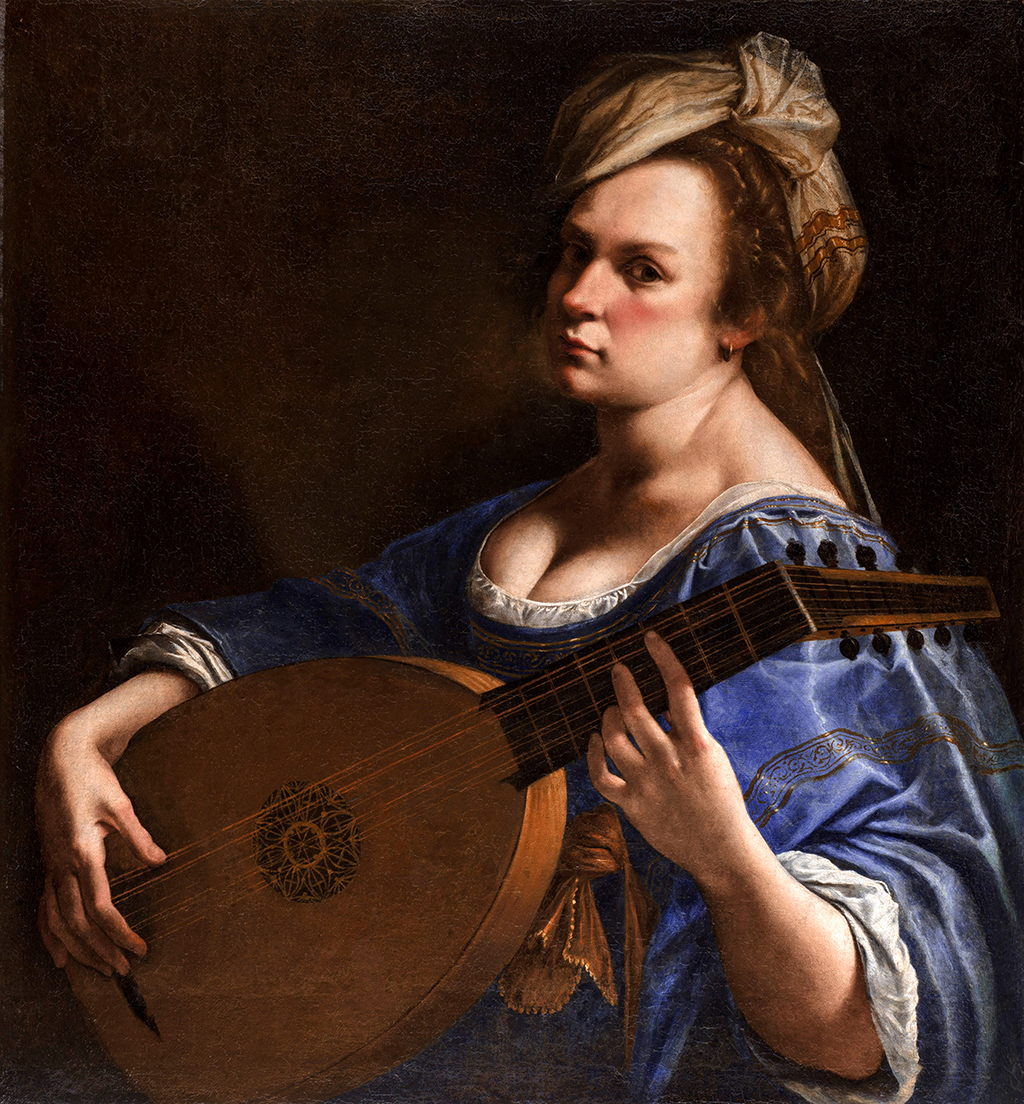Self-Portrait as a Lute Player by Italian painter Artemisia Gentileschi, is an oil on canvas from 1616-18 with dimensions 77.5 × 71.8 cm. The painting is housed in the Wadsworth Atheneum collection in Connecticut, USA.
This painting stands out as it is a self-portrait but isn't a particularly flattering or graceful self-portrait, but shows the painter playing the lute, indicating that this is her passion. A self-portrait of a female artist at the time would be quite rare. The painting background is a dark brown, with shadow and light. The portrait is upper body and head, with the profile on one side of her face turned to look at the artist but both eyes are visible. The subject's expression is almost neutral, serious but not very serious, concentrating on the lute maybe. She has long light brown hair, wrapped in a shimmering gold and beige headscarf which doesn't cover all of her hair. She has a handsome face with eyes that are possibly green, a slight shadow under them, neat eyelashes and eyebrows, her forehead is high, with the hair swept off it, and she has a nicely shaped nose and lips.
Her cheekbone is prominent, with a blush, real or artificial, running along under her eye. Only one cheek is visible as one side of her face is in shadow. Her chin and nose also have a certain blush to them. She wears a small gold hoop earring and her ear is small and fine, partly visible under her hair. The subject's neck is fully visible and lacking in signs of age, her neck is bare and free from necklaces and ornaments. She is dressed in a silken light blue low-cut gown with an under-layer in white. Her gown highlights her bosom, giving the top of her bosom maximum exposure while uplifting it as well as exposing a good portion of her shoulder. The gown's sleeves go to just below the elbow, and there are gold bands of decoration across the gown as well as a gold sash. The feature of the painting is the lute which the subject is holding with both hands and resting on her lap, she has both hands on the strings of the lute, as if to play. Her hands and arms are fine but muscular and her fingernails are short. The lute is beige and brown, five or six strings and medium sized, it has an intricate pattern in its centre and is oval in shape and has a bent stem design with tuning knobs on the top end.
The artist produced Self-Portrait as a Lute Player in around 1615-1617 and its similarity to Self-Portrait as Saint Catherine of Alexandria would clearly suggest that the two pieces were constructed either one after another, or possibly even at the same time. For example, the facial structure and placement is near identical from one to another and scientific comparisons have drawn the conclusion that the artist may have used tracing in order to make the two so similar in that regard. Other parts of them differ, though, and this suggests at the order in which she completed the different parts of both paintings. The paintings were produced in Gentileschi's studio in Florence and she consistently found models too expensive to employ regularly, therefore choosing to use her own image more frequently than she might otherwise have done. Thankfully for her own career, she was naturally pretty and had a strong facial structure which made her well suited for self portraits or to pose in other guises as she would also do.
The main difference to be found between this painting and Self-Portrait as Saint Catherine of Alexandria which is now to be found at the National Gallery in London, UK, would have to be the style of the clothing found in both artworks. Within Self-Portrait as a Lute Player the artist wears beautiful and carefully crafted items, such as a patterned dress with a matching cloth which holds her hair in place. Her lute also holds considerable decorative detail around its centre and it is the royal blue tone of her dress most of all which really leaves behind a more grand and elegant finish. Scientific research has also revealed that there was already a portrait upon the canvas prior to the lute player then being painted over the top. She would actually turn the canvas upside down and start again, quickly covering the original work and starting again in order to simply save money by re-using this canvas. This links with her well known preference for self-portraiture because of the high price of employing models as well.
You will find this exquisite portrait within the collection of the Wadsworth Atheneum in Connecticut, USA. They have a varied selection of art and antiquities, with a section devoted purely to the genre of European paintings. Some of the highlights to be found here include the likes of St Francis in Ecstasy by Caravaggio, Interior of a Picture Gallery with the Collection of Cardinal Silvio Valenti Gonzaga by Giovanni Paolo Pannini, Claude Monet Painting in His Garden at Argenteuil by Pierre-Auguste Renoir and also The Lady of Shalott by William Holman Hunt. Most interestingly from the perspective of Artemisia, there is also Judith and Her Maidservant with the Head of Holofernes as complete by her father, Orazio, which dates from around 1621-1624, which was just a few years after his daughter's painting which we find displayed here in front of us. The venue remains one of the oldest art institutions in the country, having been opened way back in the mid-19th century.





